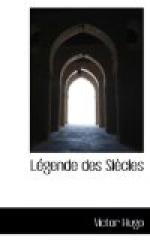If, passing from the underlying conception to the actual material of the Legende, we ask to what extent the poems can be regarded as history, the answer must be that they are not history at all in the ordinary sense of the word. In his Preface Hugo remarks: ’C’est l’aspect legendaire qui prevaut dans ces deux volumes.’ As a matter of fact, there is not a single poem in any of the series which is a narrative based upon actual fact. Of the pieces in the present volume, Le Mariage de Roland, Aymerillot, and Bivar are founded on legends. Eviradnus and La Confiance du Marquis Fabrice are inventions, and the others are mostly embroideries woven upon ancient themes rather than historical or even legendary pictures. These latter, of which La Conscience is the best instance in this volume, suggest De Vigny’s conception: ’Une pensee philosophique, mise en scene sous une forme epique ou dramatique.’ Of accuracy in detail and local colour, Hugo was utterly careless. He possessed a capacious, but not an exact, memory, and, provided the general impression produced by a description was the true one, he did not stop to inquire whether every detail was correct. Nor did he always enjoy an extensive knowledge of the epoch which he delineated. But he possessed to the full the poet’s faculty of building the whole form and feature of a past age out of a few stray fragments of information. The historical colour of Ruy Blas is said to be based on two French books, carelessly consulted, yet of Ruy Blas M. Paul de Saint-Victor, after making a close study of the period, wrote: ’Ce fragment de siecle que je venais d’exhumer de tant de recherches, je le retrouvais, vivant et mouvant, dans l’harmonie d’un drame admirable. Le souffle d’un grand poete ressuscitait subitement l’ossuaire des faits et des choses que j’avais peniblement rajuste.’[3]
[Footnote 3: Quoted in Eugene Rigal’s Victor Hugo, poete epique.]
Moreover, inaccurate as Hugo often is, it is never the inaccuracy that falsifies. He has been severely criticized for having in Au Lion d’Androcles assigned to a single epoch events and personages which are really separated by centuries. But all the facts are typical of the spirit which dominated Imperial Rome, and combine therefore to form a description which has poetic and imaginative, if not historical, truth. And if, with greater licence, he has accumulated upon the head of a single Mourad all the crimes of a long line of Sultans it is because in drawing Mourad he is drawing the Turkish nation. Mourad is to him the typical Turk, the embodiment of Oriental cruelty and lust. If again, to pass to a larger subject, he has chosen legend rather than history as the basis of many of his poems, it is not only because of his own innate love of the marvellous and romantic, but because he cared for the truth embodied in legend more than the truth embodied in chronicle. If




